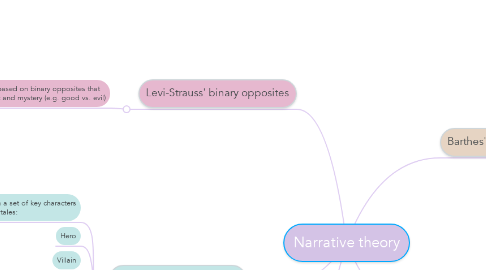Narrative theory
by Hannah Fletcher

1. Levi-Strauss' binary opposites
1.1. Narrative is based on binary opposites that bring conflict and mystery (e.g. good vs. evil)
2. Todorov's equilibrium theory
2.1. Narratives use a equilibrium - disequilibrium - re equilibrium structure to keep the audience engaged
3. Propp's spheres of action
3.1. Narratives often contain a set of key characters that were found in fairy tales:
3.2. Hero
3.3. Villain
3.4. Donor
3.5. Anti-hero
3.6. Princess
3.7. Princess' father
4. Barthes' codes
4.1. Codes help an audience understand a narrative:
4.2. Enigma codes
4.3. Cultural codes - represent where the characters are using signs (e.g. landmarks)
4.4. Action codes - indicate that something will happen (e.g. a character reaches for a gun - someone may get shot)
4.5. Symbolic codes
5. Syd Field's 3 act structure
5.1. Act 1 is the build up that sets the tone of the story and introduces the narrative. There is then a turning point leading into act 2 which develops the narrative further and ends in another turning point. Act 3 contains the resolution to a problem and completes the narrative


